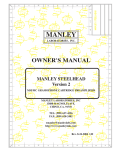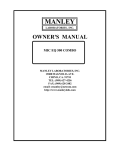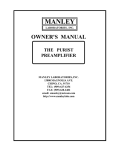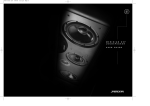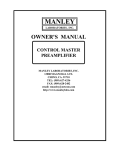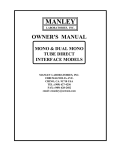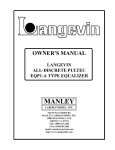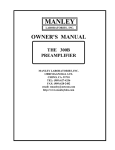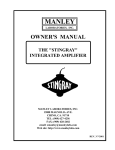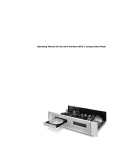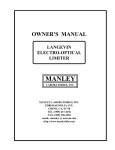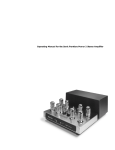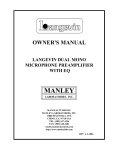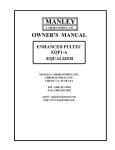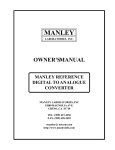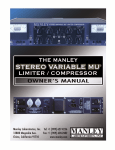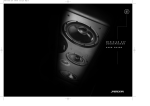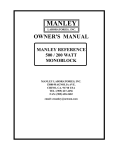Download Manley MM/MC GRAMOPHONE CARTRIDGE PREAMPLIFIER Owner`s manual
Transcript
MANLEY LABORATORIES, INC. OWNER'S MANUAL MANLEY STEELHEAD MM/MC GRAMOPHONE CARTRIDGE PREAMPLIFIER MANLEY LABORATORIES, INC 13880 MAGNOLIA AVE. CHINO, CA. 91710 TEL: (909) 627-4256 FAX: (909) 628-2482 [email protected] http://www.manleylabs.com CONTENTS SECTION PAGE INTRODUCTION 3 INSTALLATION PRECAUTIONS 4 FEATURES AND APPLICATIONS 5 OPERATIONAL NOTES 9 TROUBLESHOOTING 12 SPECIFICATIONS 14 WARRANTY 15 WARRANTY REGISTRATION 16 INTRODUCTION THANK YOU!... ...for choosing The MANLEY STEELHEAD phono preamplifier. Please read over this manual carefully as it contains information essential to the proper operation and maximum enjoyment of this instrument. The MANLEY STEELHEAD is designed to provide that rare combination of maximized sonic performance coupled with a generous ability to adapt to any moving magnet, moving coil or iron vane phono cartridge you may wish to use. With the STEELHEAD’s feature compliment, you no longer have to settle for what a given cartridge sounds like with a fixed predetermined preamp load impedance, or wonder what that same cartridge might sound like when presented with different loading arrangements. What best suits your particular phono cartridge, system, listening room and personal preference is now merely a flick of a switch away! The STEELHEAD adapts to accommodate your situation, rather then the other way ‘round. To this end you will notice that it is the anticipation of your preamplifier needs which has driven every detail of the STEELHEAD’s planning, engineering, styling, operating convenience and adaptability. UNPACKING Unpack the preamplifier carefully and make sure that all supplied accessories are present. Examine all items for any possibility of shipping damage. All six tubes should be standing at attention in their sockets. If the preamplifier is damaged or fails to operate, notify the shipper and your dealer or us immediately. Or if the preamp was shipped to you directly, notify the shipping company without delay. Your STEELHEAD preamp was packed with the following accessories: a) b) c) 1 each Power supply unit with interconnect cable. 1 each 6 foot IEC 3-conductor power cable. 1 each Owner’s manual. It is prudent to retain the shipping materials for future use, as these materials are custom formed for the preamp and will greatly minimize the chance of shipping-related damage. INSTALLATION PRECAUTIONS a) Avoid locating the preamp where it will be exposed to direct sunlight, excessive humidity, dust or moisture. Extreme environments may temporarily or permanently degrade preamp performance. b) Keep the preamp housing away from sources of strong magnetic field radiation, such as large video display CRTs, large power lines or power/audio transformers in nearby equipment. Extra measures have been taken to shield the magnetically sensitive bits inside the preamp housing. Nevertheless these measures can be overwhelmed by strong outside influences. Keep in mind that the tiniest disturbance along with the desired signals will be amplified many hundreds or thousands of times. c) Locate the preamp away from heat-radiating sources, such as other large amps, political demagogues or space-heating equipment. d) Make sure the preamp and power supply is off before making any system connections. Do not remove or insert the large 16-pin circular power supply connector when the power supply mains switch is in the on (|) position. Do not hot plug the system. e) Dissipate any static electric charge build-up on your body by touching the enclosure before making or changing any system connections. The preamp electronics are fairly robust as far as immunity to damage from static charge is concerned, but total immunity cannot be had without unacceptable compromise of audio performance. f) Be careful to feed only low-level phono cartridge signals to the preamp input connectors. Sustained line-level signals above 15 volts peak may cause damage to sensitive MC input stages even when the preamp is in the standby mode or when the power is off. AC VOLTAGE SELECTION The STEELHEAD system may be set to operate on either 117 or 234 volts A.C. by means of a rotary switch located on the power supply P.C. board. The power supply's mains-voltage selector switch is normally preset to the mains voltage at the customer's location prior to shipment. If, however, the preamp provenance is unknown then the mains-voltage selector switch should be checked and reset to the correct voltage if necessary. The mains fuses must also be checked for proper ratings and changed if necessary. Failure to correctly set the mains selector switch or use properly rated fuses can cause extensive damage to the system which is of course not covered by the warranty. The mains fuse may be checked by first disconnecting the IEC mains cord from the power supply’s power inlet plug. Then gently press the small leaf spring on the side of the rectangular gray fuse retainer cap. The fuse and cap should spring outward toward your fingers. Inspect the fuse for the proper rating; change if necessary. Refer to the fuse-rating chart in the specifications section of this manual. To inspect or adjust the mains-voltage selector switch it will be necessary to remove the top cover of the power supply enclosure. For this you will need a #1 Philips screwdriver, and a 3/16 inch flat blade driver to change the selector switch setting. Before opening make sure that the power supply is unplugged from mains power and the STEELHEAD preamp. Once inside you will see tall cylindrical high voltage energy-storage capacitors, which can be a shock nuisance even when the supply is not energized. Therefore, if the supply has been recently power cycled, let the supply capacitors discharge for 15 minutes prior to opening. Then remove 8 Philips 4x40 retaining screws from the cover, followed by the cover. Locate the voltage selector switch near the mains power entry / fuse / power switch module. The switch face is the black round object, about 1/2 inch in diameter, with white voltage numbers “110” and “220” on the rotor and a white triangular selection indicator on the stator. Notice that the “110” and “220” markings on the switch should not be interpreted as being the precise voltage needed to operate the preamp system. Using the 3/ 16 inch screwdriver rotate the switch, if necessary, so that the mains voltage you intend to feed the power supply lines up under the selection indicator. Be sure to replace all screws when reassembling. FEATURES AND APPLICATIONS 1. HIGH PERFORMANCE FRONT END The STEELHEAD preamplifier makes the best use of active and passive component and circuit developments generated over the past half-century. The hybrid cascode gain blocks simultaneously deliver wide-band high-gain, low noise and low distortion performance without having to resort to heavy-handed amounts of negative feedback. Or overly complex circuit topology. The multiplicative aspect of the cascoded device’s output (anode) impedance means that the most important characteristics of each gain stage are preserved even though the local negative feedback present in each block is very small. This approach makes the amplification factor of each stage insensitive to tube gain or transconductance variations which occur due to device production tolerance allowances or aging. Other uncommon traits include high quiescent and operating current in each gain stage. This lowers the static and dynamic impedances found within each stage and raises system bandwidth. Musical material which would cause a cave-in of the typical current-starved 12AX7-based preamplifier circuit are conveyed unflinchingly by these amplifier stages. 2. ACCURATE “4-CORNER” RIAA EQUALIZATION In the spirit of high fidelity, all four RIAA phono equalization corner frequencies or time constants have been specifically addressed in the STEELHEAD preamplifier. Historically most designs have concentrated on the “big three” time constants of 3180, 318 and 75 microseconds. This ignores the fourth corner of about 3.2 us, which when ignored causes most phono stages to continue rolling off the highest octave signals coming from the phono pickup, rather than turning the final “corner” and shelving to flat response at about 50 kHz. Careless removal of upper octave bandwidth causes the recovered audio to become somewhat lifeless and remote, with needless loss of impact, detail and percussiveness. Ironically this signal content is precisely what is omitted from all currently popular digital audio delivery formats, and is one of the chief culprits behind the homogenous upper octave sonic characteristics of those formats. As with all equalizing amplifiers intended to correct a given form of frequency-selective emphasis curve, care must be used when building the restorative compensation networks. Great care must be exercised if the goal is to produce a highly accurate passive network coupled to lowfeedback amplifiers. And experience has shown that the effort spent in faithfully adhering to the inverse RIAA equalization curve produces results that easily justify the additional procurement and manufacturing costs. To this end, only hand-selected and/or1% tolerance components are used throughout the RIAA equalization network. Add to that the factory-set variable capacitors, and the result is very high equalization accuracy where small component and circuit layout variations that other manufacturers ignore are netted out. This yields impeccable inter-channel phase and gain matching at any gain setting. In short, the STEELHEAD will magnify the differences in the character and personality of your vinyl recording collection, cartridge, tonearm and turntable. A microscope for the ear! Be prepared to hear previously undiscovered musical content as you play back your favorites! 3. SWITCH-SELECTABLE CARTRIDGE LOAD IMPEDANCE An effective means of varying the load seen by the MC cartridge has been included in the form of a 5-position rotary switch. This switch selects various taps on a specially manufactured dual-primary bi-filar wound, high-bandwidth low-resistance and multiple-shielded nickel-core step-up autoformer. A drama to make, the autoformer permits the minute MC cartridge signal power to be efficiently and transparently transformed from low-volts/high-current to high-volts/ low-current. By avoiding conventional parasitic cartridge termination resistors, none of the MC cartridge’s tiny signal power is thrown away before amplification. This results in improved system signal-to-noise ratio. Quite worthwhile provided, as in the STEELHEAD, the autoformer has the necessary performance for the job. This pivotal component has had engineering attention lavished upon it in the only way possible or practical: The Manley Labs magnetics department. In-house transformer prototyping and manufacturing capabilities permit realization of extraordinary transformer designs. You may now audition your MC cartridge at or near the manufacturer’s specified loading resistance without sacrificing any signal power through a parasitic load resistor. And explore the interesting tonal shifts caused by intentional mild or severe mis-termination of the cartridge. The “right” setting will ultimately depend on the cartridge in use, type of music being heard, other downstream equipment and, most importantly, your personal preference. There will no doubt be moments when a technically “wrong” setting will be musically “right” for a given situation. Do rest assured that, in this instance, a technically wrong setting is completely harmless for all equipment involved. In the case of the MM input, the typically higher cartridge output levels allow fixed resistor termination, with clockwise-most switch setting being the standard 47k-ohm load resistance. Those MM cartridges capable of properly driving low impedance loads between 25 and 400 ohms should be auditioned through both the MM and MC inputs. By doing so you may find the most appropriate sonic character through the use of unconventional input arrangements. In short, experiment; don’t let the control labeling stop you. On the contrary, we invite you to tweak away! 4. SWITCH-SELECTABLE CARTRIDGE TERMINATION CAPACITANCE on the front panel yet! Termination capacitance may be applied to each channel independently in 10 pF steps, up to 1100 pico-Farads. The termination capacitance is present at the gain-stage inputs, and is not affected by input selector or gain switch changes. For best accuracy consult your phono interconnect cable literature or manufacturer to determine how much of the termination capacitance may be attributed to the cable. Then subtract at least that amount from the target capacitive termination value. If the interconnect manufacturer does not know the amount of capacitance per unit length that their wire presents (!), then refer to the following example for a starting point: Typical phono interconnect cables will exhibit self-capacitance on the order of about 30 pF per foot. If the interconnect cable is 3 feet (~ 1 meter) in length, you may expect about 90-100 pF of input capacitance to be present due to the interconnect cable alone. If the cartridge manufacturer specifies a load capacitance of 150 pF then it is best to subtract the cable’s portion, i.e. 90 pF. This yields a balance of 40 pF. Thus, the audition should start with the termination capacitance switches set to 40 pF. Each cartridge manufacturer’s product will work best in a laboratory sense when terminated (loaded) with a certain amount of resistance and capacitance. By lab sense it is meant that the signal developed by the cartridge is at maximum power transfer into the pre-amp, with minimum overshoot and ringing, flattest frequency response and gentle roll-off characteristics. But it is those settings that create the most musically satisfying results for you that are of uppermost importance. And your termination preferences may rightly deviate unpredictably from some labbased norm. A good place to start is with those values recommended by the cartridge manufacturer, less the interconnect cable capacitance. A good default value, if the recommended cartridge load capacitance is unknown, is 150 pF, the sum of cable and termination capacitance switch settings. This value reflects a de facto standard as used by pre-amp manufacturers past and present. From there we encourage you to scrutinize a range of switch settings until you find those values which best suit you and your accompanying components. Also notice that the audible affects of varying the termination capacitance can differ substantially between cartridge types and brands. This is to be expected due to the greatly varying source impedance characteristics of the cartridges available today. In general you may expect the termination capacitance value to alter, at one extreme, subtle imaging and spatial cues, and at the other high-frequency content, forwardness and speed of the reproduced sound. As with the load Z switch, feel free to tune the termination capacitance switches for maximum sonic satisfaction even though the final setting differs from the cartridge manufacturer’s specs. 5. SWITCH-SELECTABLE AMPLIFIER GAIN Cartridge output levels and downstream line-level interconnect drive voltage requirements can vary greatly between manufacturers. Hence a four-step amplifier-block gain control has been included to accommodate these differences, as well as differing cartridge sensitivities. You may select from 50 to 65 dB of gain in 5 dB steps. The gain figure is referred to amplifier gain at 1 kHz. Notice that the pre-amp gain is about 20 dB higher (10 times) at 20 Hz and about 20 dB lower (0.1 times) at 20,000 Hz. The MC step-up autoformer may also provide approximately 2 to 12 dB of additional voltage gain depending on cartridge source impedance and load switch setting. 6. PUSH-BUTTON SWITCH FUNCTIONS Four feature switches have been provided for a variety of utility functions. STANDBY toggles the STEELHEAD between normal operating state and a near zeropower sleep mode. No operating voltages are present when in sleep mode, except for some keepalive CMOS system control logic, energized by a separate small mains transformer in the power supply. SUM combines the amplified audio into a binaural signal, present at the VARIable outputs only. Monophonic or the lateral-only modulation content of your stereo records may now be heard. True mono may be experienced if the feed to one of your two loudspeakers is cut. DIM reduces the output level by 20 dB, or about 1/4 previous volume. The DIM function is effective at the VARIable outputs only. Notice that preamp specifications at the VARIable output may be slightly compromised with the DIM feature engaged. This feature should be treated as a convenience for use when, for example, cueing up a record. System-menacing pops and thumps due to needle-drop are held at bay yet sound from the pick-up may still be heard. MUTE kills audio signals present at both the FIXED and VARIABLE outputs. 7. BUFFERED VOLUME CONTROL The STEELHEAD is equipped to drive external power amplifiers directly via low output impedance VARIable line drivers. Purists may easily bypass other outboard preamplifier circuitry by connecting power amplifier inputs directly to the STEELHEAD’s VARIable output jacks. 8. SEPARATE BUFFERED FIXED AND VARIABLE OUTPUTS Choice of constant-level source for interconnection to a line-level-only preamp or recorder, and variable outputs for direct connection to power amplifiers. 9. DISCRETE CIRCUIT AND CHASSIS GROUND POINTS Breakable link between electronics common “zero volts” point and chassis ground allows great flexibility in grounding arrangements. 10. REMOTE HIGH PERFORMANCE POWER SUPPLY Multiple channel power supply in separate enclosure eliminates supply proximity-based noise intrusions into the signal path. Robust and regulated ultra quiet high-voltage rail maintains electrical quiet for sensitive gain input stages. Each voltage channel is conveyed to the preamplifier via separate source and sink lines; no common supply points except at the star-grounding point on the amplifier boards. Multi-core interconnect cable is screened via tinned overall shield braid. OPERATIONAL NOTES VOLUME INPUT GAIN dB MC LOAD Z, ohms LOAD CAP, pF x 100 3 2 1 0 4 5 6 3 7 8 9 10 2 1 0 100 100 x 10 4 5 3 7 8 MMMC LOAD CAP, pF x 100 6 MC MM 2 4 5 6 x 10 3 7 8 9 1 9 10 0 10 2 1 0 4 5 6 7 8 9 10 PREPARATION FOR INSTALLATION Budget a suitable space in which to place the preamplifier, power supply and associated interconnect cable. This space should be free of strong external magnetic and RF fields, and reasonably removed from strong loudspeaker-generated acoustical fields. This space should also be free of excessive heat or dust and large enough to permit easy flow of cool air to the top, bottom and sides of the preamp and power supply. Make sure the power supply’s mains voltage selector switch is set to match the local line voltage, and the wire link is present between the preamp’s green CHASSIS and black CIRCUIT ground mini binding posts on the rear panel. Try to position the power supply away from any interconnect cables which may be carrying audio signals. BEFORE POWER-UP Once placed, join the power supply cable to the pre-amplifier via the large16-pin circular connector. The 16-pin connectors are keyed and can only be mated when both halves are lined up correctly. Check and make sure the power supply is switched off, then attach the grounded IEC power cable jack to the IEC plug. Keep the power off until all other system connections are completed. Proceed by connecting the input and output cabling to the signal sources and loads as desired. Tie any separate turntable or tonearm ground lead to the gold CHASSIS ground binding Set the GAIN dB control to 55 dB and VOLUME control to about 9 o’clock. Choose the MM or an MC input, as necessary, with the INPUT control. Place the LOAD Z switch to a value at or near that recommended by the cartridge manufacturer. Adjust the LOAD CAP switches to a value at or near that recommended by the cartridge manufacturer less any interconnect cable capacitance. Select and clean, if necessary, your favorite gramophone record.... Plug the power cable in and place the power supply’s mains power switch in the on (|) position. The STANDBY switch should glow. Push the STANDBY switch. The STANDBY switch will go dark, selected INPUT and GAIN blue LED’s will illuminate, the MUTE switch lamp will start flashing and the power supply pilot LED and the MANLEY STEELHEAD badge will light up. The winking MUTE lamp indicates the beginning of a 30 second warm-up mute delay, during which time the muting relay is engaged; no output will be heard from the preamp. DURING OPERATION Once audio is heard from the STEELHEAD the exploration for the ideal control settings can begin. However it would be best to allow about 15 minutes of warm-up time for the system to reach thermal equilibrium. Again, notice that the MUTE function operates over both FIXED and VARIable outputs, while the DIM and SUM functions are only available at the VARIable output jacks. RETURNING TO STANDBY MODE At the conclusion of your listening session press the STANDBY switch again to cut power to the preamp. Notice that effort has been made to keep power engagement and cessation noise generated by the preamp to a minimum. Nevertheless it is wise to remove power mains and signal feed to your power amps when the preamp is undergoing a power state change. Additionally, it is best to return the STEELHEAD to the STANDBY mode when not in use rather then leaving the power on indefinitely. This will enhance tube and system life. The tubes should last thousands of hours under normal conditions. REPLACING A TUBE OR ILLUMINATED BADGE LAMP Yes there are user-servicable parts inside! But, as with other vacuum tube based products, there is also high voltage present. Therefore caution must be used when covers are removed; otherwise there could be shock hazard. As with all mains-powered gear make sure the mains power is off and mains cords are unplugged. Then unplug the power supply from the preamp. If the preamp has been powered up within the last 15 minutes stop! and let the large internal capacitors finish discharging. Wait about 5 minutes before opening the preamp once the 16-pin connector is unplugged. You will need a #1 Philips screwdriver and a small slot driver. FUSE-LAMP REPLACEMENT: After removing the cover use the small slot driver to help pry the badge’s fuse-lamp out of the clip holder. Use one hand only when reaching into the enclosure or touching any components inside. Keep the other hand away from the preamp, preferably in your pocket. TUBE REPLACEMENT: Increased noise level whether gradual or abrupt can generally be attributed to aging tubes. Gradual noise increase from weakened tube cathode emission is the chief symptom of an aging tube, which may be accompanied by exaggerated distortion or loss of headroom. The noise may be a variation in the level of hiss, or the noise may develop a more granular “large-curd” quality. Should these symptoms appear, unplug the tubes in the offending channel and replace with new devices of known-good quality. If the front-end 6922 tube is being replaced in one channel it is wise to replace the same tube in the alternate channel, preferably with matching manufacturer and date code if possible. Let the preamp tube(s) cool down, if necessary, before handling. Tube heater filaments are somewhat more suceptable to damage when warm or hot. Each tube should require only moderate force for removal and replacement. Gently rock the tube back and forth a bit during removal or replacement. Avoid bending the circuit board. Notice that the heaters of the 6922s are connected in series, and neither channel will function if one of the filaments is open or burned out, or unless both of the 6922s are installed. Akin to those old Xmas tree lights in the attic, no? Be careful to straighten any bent tube pins prior to installation; pin misalignment will make fitting the replacement tube difficult or impossible, and may damage the socket. Be careful to put replacement tubes in the proper sockets. Never substitute other type numbers of 9-pin tubes without careful research. There are literally thousands of types that share the 9-pin mechanical basing arrangement, but NOT the internal electrical connections! Mechanically compatible tube plugs and sockets by no means indicate electrical compatibility! And random experimenting can easily and quickly destroy the substitute tube and other parts of the preamp! Three tube types that are electrically and plug-socket compatible with the 6922 dual triode are the 7308, 6DJ8 and the ECC88 / E88CC. There is no direct replacement for the 7044 dual triode. MC-2 RIGHT OUTPUTS GROUND RIGHT INPUTS LEFT INPUTS CHASSIS LEFT OUTPUTS CHASSIS VARI FIXED MM MC-1 MC-1 MM FIXED VARI CIRCUIT Please direct any questions to your dealer or MANLEY LABS for further assistance. TROUBLESHOOTING The STEELHEAD’s system architecture is designed with a variety of features so as to allow flexibility in accommodating as many cartridges and as much downstream gear as possible. Access to these capabilities rest on the assumption that all STEELHEAD systems are functioning properly. If trouble is encountered please review the following short list of symptoms and corrective remedies before contacting your dealer or us. Symptom Possible Cause Corrective Action NO lights, power. Bad mains fuse. Bad or unplugged power cable. AC outlet not energized. Rolling Grayout®™ Replace with correct fuse. Check cables and outlets. Power supply pilot ON, ‘HEAD not responding. Dim badge lamps, LEDs. Weak output. Abandon California, elect Libertarians. 16-pin connector not seated. Check for proper connection. Mains Voltage selectorCheck for proper setting. switch set to 220 V instead of 110 V. Be sure of local mains voltage before changing switch setting! Tube locator diagram 7044 7044 6922 RIAA amp board 6922 7044 Output heard in one channel only. Bad tube in affected channel. Alternate or replace suspect tube. Weak or distorted output in one channel. Bad tube in affected channel. Alternate or replace suspect tube(s). 7044 Symptom Possible Cause Lights ON, no output either channel after warm up delay times out. Open 6922 filament, either channel. 6922 unplugged. Check for glowing 6922 filaments. Replace if necessary. Output MUTE function activated. UnMUTE the preamp. Input connectors are nonshorting. Avoid unused inputs; install shorting plugs. Hum heard on unused MM or MC inputs. Corrective Action, cont’d Hum heard on active inputs. Ground link between CHASSYS and CIRCUIT open. Replace jumper if necessary Turntable / tonearm ground Establish inter-chassis link to CHASSIS open. connection. Open cartridge leads. Check lead / head-shell continuity. Phono plugs not fully inserted. Check for proper connection. ‘Table lines close to hum magnetic field. Keep source lines away from transformers, motors, etc. Ground loop between STEELHEAD and turntable or downstream pre-amp/ power amplifiers. Break ground connection of one or two of the three system elements. Experimentation may be necessary. Faulty shield connection, Roll or swap cables, or input or output interconnect replace cables. cables. No or bad sound heard on MC2 input. Check DIN plug wiring Left: 1high, 4 low. Right: 3 high, 5 low, Shield: 2 earth, chassis. Re-wire plug for continuity. Remarks on hum pick-up: Please be aware that the STEELHEAD can develop voltage amplification factors as high as 30,000 times, or 90 dB at the 50-60 Hz power line “hum” frequencies. It is of the utmost importance that cables handling the tiny signals from the phono cartridges be of high quality, with good screening and connection properties, if the single-ended signal is to have any chance of being received by the preamp reasonably free from hum and noise intrusions. This is especially true formoving coil pickups. Please use the shortest practical interconnects and carefully route these away from all possible electrical or magnetic hum or interference sources. SPECIFICATIONS Vacuum tube compliment: 6922 x 2 (gain) plus 7044 x 4 (output buffers) Fuse type and ratings: 117 VAC: 1.5 Amp 3AG slow-blow main 0.5 Amp 3AG slow-blow logic 234 VAC: 0.75 Amp 3AG slow-blow main 0.25 Amp 3AG slow-blow logic Moving Magnet input impedance: 5-step user adjustable via fixed low-noise resistors. 25, 50, 100, 200 and 47000 ohms. Moving Coil input impedance: 5-step user adjustable via multi-tap autoformer: 25, 50, 100, 200 and 400 ohms. Input Termination Capacitance: Variable in 10 picofarad steps from 10 to 1100 pF. (1.1 nF). Residual input capacitance less than 40 pF. Gain Steps: 4-step user adjustable, 50, 55, 60 and 65 dB active gain at 1 kHz referred to FIXED output jack, 10 k-ohm load. Additional gain available via MC step-up autoformer. Deviation from RIAA curve: Less than +0.5 / -0.3 dB from 20 Hz to 20 kHz, any gain setting. Typically less than +/- 1 dB from 10 Hz to 100 kHz Inter-channel differential phase: Less than 4 degrees from 20 Hz to 20 kHz, any gain setting. Typically less than 2 degrees. Inter-channel differential gain: Less than +/- 0.5 dB from 20 Hz to 20 kHz, any gain setting. Dynamic Range: 101 dB @ 1 kHz, 1% THD 200 ohm source, 47 k-ohm input, @55dB Gain 97 dB @ 1 kHz, 0.1% THD Maximum Output: +27dBm @ 1KHz with 3% THD into 100Kohm load FIXed Output impedance: 150 ohms. Minimum suggested load greater than 1500 ohms. VARIable Output impedance: 75 ohms. Minimum suggested load greater than 600 ohms. MM Noise (S+N+D) / (N+D): 200 ohm source, 47 k-ohm input A-weighted Referred to 2.54 mV rms @ 1 kHz. GAIN setting 50 dB: 55 dB: 60 dB: 65 dB: MC Noise (S+N+D) / (N+D): 100 ohm source, 100 ohm input A-weighted Referred to 0.5 mV rms@ 1KHz and rated input impedance 50 dB: 55 dB: 60 dB: 60 dB: Fixed Ouptut Vari O/P 86 dB 108dB 99dB 86dB 84 dB 108dB 99dB 85dB 80 dB 108dB 94dB 80dB 75 dB 108dB 89dB 75dB 9:00 12:00 V/C FULL 84 dB 108dB 98dB 85dB 80 dB 108dB 95dB 81dB 75 dB 108dB 90dB 76dB 70 dB 107dB 85dB 71dB WARRANTY All Manley Laboratories equipment is covered by a limited warranty against defects in materials and workmanship for a period of 90 days from date of purchase to the original purchaser only. A further optional limited 5 year warranty is available to the original purchaser upon proper registration of ownership within 30 days of date of first purchase. Proper registration is made by filling out and returning to the factory the warranty card attached to this general warranty statement, along with a copy of the original sales receipt as proof of the original date of purchase. Only 1 card is issued with each unit, and the serial number is already recorded on it. If the warranty registration card has already been removed then this is not a new unit, and is therefore not warranted by the factory. If you believe this to be a new unit then please contact the factory with the details of purchase. This warranty is provided by the dealer where the unit was purchased, and by Manley Laboratories, Inc. Under the terms of the warranty defective parts will be repaired or replaced without charge, excepting the cost of tubes. No warranty is offered on tubes, unless: 1. a Manley Laboratories preamplifier is used with a Manley Laboratories amplifier, and 2. the warranty registration card is filled out. In such a case a 6 month warranty on tubes is available with the correct recording of the serial number of the preamplifier on your warranty registration card. If a Manley Laboratories product fails to meet the above warranty, then the purchaser's sole remedy shall be to return the product to Manley Laboratories, where the defect will be repaired without charge for parts and labour. The product will then be returned via prepaid, insured freight, method and carrier to be determined solely by Manley Laboratories. All returns to the factory must be in the original packing, (new packing will be supplied for no charge if needed), accompanied by a written description of the defect, and must be shipped to Manley Laboratories via insured freight at the customer's own expense. Charges for unauthorized service and transportation costs are not reimbursable under this warranty, and all warrantees, express or implied, become null and void where the product has been damaged by misuse, accident, neglect, modification, tampering or unauthorized alteration by anyone other than Manley Laboratories. The warrantor assumes no liability for property damage or any other incidental or consequental damage whatsoever which may result from failure of this product. Any and all warrantees of merchantability and fitness implied by law are limited to the duration of the expressed warranty. All warrantees apply only to Manley Laboratories products purchased and used in the USA. Some states do not allow limitations on how long an implied warranty lasts, so the above limitations may not apply to you. Some states do not allow the exclusion or limitation of incidental or consequential damges, so the above exclusion may not apply to you. This warranty gives you specific legal rights and you may also have other rights which vary from state to state. WARRANTY REGISTRATION We ask that you please fill out this registration form and send the bottom half to: MANLEY LABORATORIES REGISTRATION DEPARTMENT 13880 MAGNOLIA AVE. CHINO CA, 91710 or FAX it (909) 628-2482 or email [email protected] with all the info requested below and a note stating this is Warrantee Registration. Registration entitles you to product support, full warranty benefits, and notice of product enhancements and upgrades. You MUST complete and return the following to validate your warranty and registration. Thank you again for choosing Manley Laboratories. MODEL _______________SERIALNo.______________________ PURCHASE DATE __________ SUPPLIER __________________ --------------------------------------------------------------------------------------------PLEASE DETACH THIS PORTION AND SEND IT TO MANLEY LABORATORIES MODEL _________________SERIAL No. __________________ PURCHASE DATE ________ SUPPLIER ___________________ NAME OF OWNER____________________________________________ ADDRESS___________________________________________________ CITY, STATE, ZIP _____________________________________________ TELEPHONE NUMBER ________________________________________ FAX _________________________________________________________ EMAIL______________________________________________________ COMMENTS?_________________________________________________
















